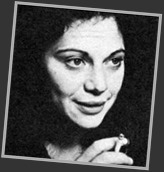 I was more than half-way through Philip Roth’s American Pastoral when I realised that the location of the prizewinning novel and recent movie may be transferred easily to the U.K., with London and the leafy outer-suburbs of Greater Manchester in north-west England as neat substitutes for Newark, New Jersey and New York, U.S.A.
I was more than half-way through Philip Roth’s American Pastoral when I realised that the location of the prizewinning novel and recent movie may be transferred easily to the U.K., with London and the leafy outer-suburbs of Greater Manchester in north-west England as neat substitutes for Newark, New Jersey and New York, U.S.A.
There must be at least one British equivalent for fictive Seymour ‘Swede’ Levov, based on an actual American Jewish athlete Seymour ‘Swede’ Masin.
 But here I want to consider Levov’s lunatic daughter, Merry whose story is remarkably similar to that of real-life British Anna Mendelssohn (’Mendleson’). In 1972 she was convicted of conspiracy to cause explosions as a member of the anarchist Angry Brigade and served more than four years of a ten year prison sentence.
But here I want to consider Levov’s lunatic daughter, Merry whose story is remarkably similar to that of real-life British Anna Mendelssohn (’Mendleson’). In 1972 she was convicted of conspiracy to cause explosions as a member of the anarchist Angry Brigade and served more than four years of a ten year prison sentence.
I am forever fascinated by Anna’s story as she and her younger sister, Judy were my contemporaries. Like me, they lived in Stockport, Cheshire during the mid-1960s and also like me and a string of present-day Anglo-Jewish celebrities, were then members of Habonim-Dror, a popular left-wing Zionist Jewish youth group.
Anna, the daughter of Maurice Mendleson, a market trader and local Labour councillor, seemed destined for success as a head girl of Stockport High School for Girls with great academic and artistic abilities.
But consistent with the time-frame of Roth’s story, in 1969 she dropped out of university without completing her degree, having joined the student political rising in Paris the previous May.
The Angry Brigade was campaigning against a range of perennially fashionable social ills, only one of which was the U.S. war in Vietnam. Members also fought against internment in Northern Ireland, governmental industrial-relations’ policies and sexism. They exploded 25 bombs, causing extensive damage to property; stole cheques and lived in abject squalor. But they did not intend to hurt anyone and only one person was ever slightly injured.
Unlike ‘Merry’, real-life Anna was simply emotionally very fragile and reportedly gave a remarkable trial speech in her own defence that spanned a day-and-a-half of court time.
After an early parole – that caused much public resentment – Anna returned to Stockport before moving to Sheffield where she started her own family. Later, she resumed her studies and then devoted herself to poetry and art, publishing pseudonymously as Grace Lake.
Her final years were led most reclusively and she died in 2009 of a brain tumour aged only 61.
In an obituary for The Guardian newspaper, Peter Riley noted that Anna’s legacy lay “…. in her unique artistic temperament, beholden to no cultural dictates, fiercely reclaiming her rights as a woman and a Jew, but partaking equally in art as a theatre of linguistic and visual delight.”
I enjoyed American Pastoral the movie very little – and the novel – despite some passages of marvelous writing - even less. They are both inordinately painful - and often painfully boring to boot.
So I can’t understand why no leading journals or their many Arts critics on either side of the Atlantic have not sought to find further real-life parallels with Roth’s fictional family in order to relieve the deadening gloom.
There must be many readers and viewers who have made an immediate connection between the people whom Roth invented and the reality of the late 1960s and early 1970s. As Roth forged the initial link between the two ‘Swedes’, only he can tell us whether he was aware of Anna Mendelssohn’s life story when he devised that of mirthless Merry. I think we should be told!
© Natalie Wood (03 January 2017)
No comments:
Post a Comment